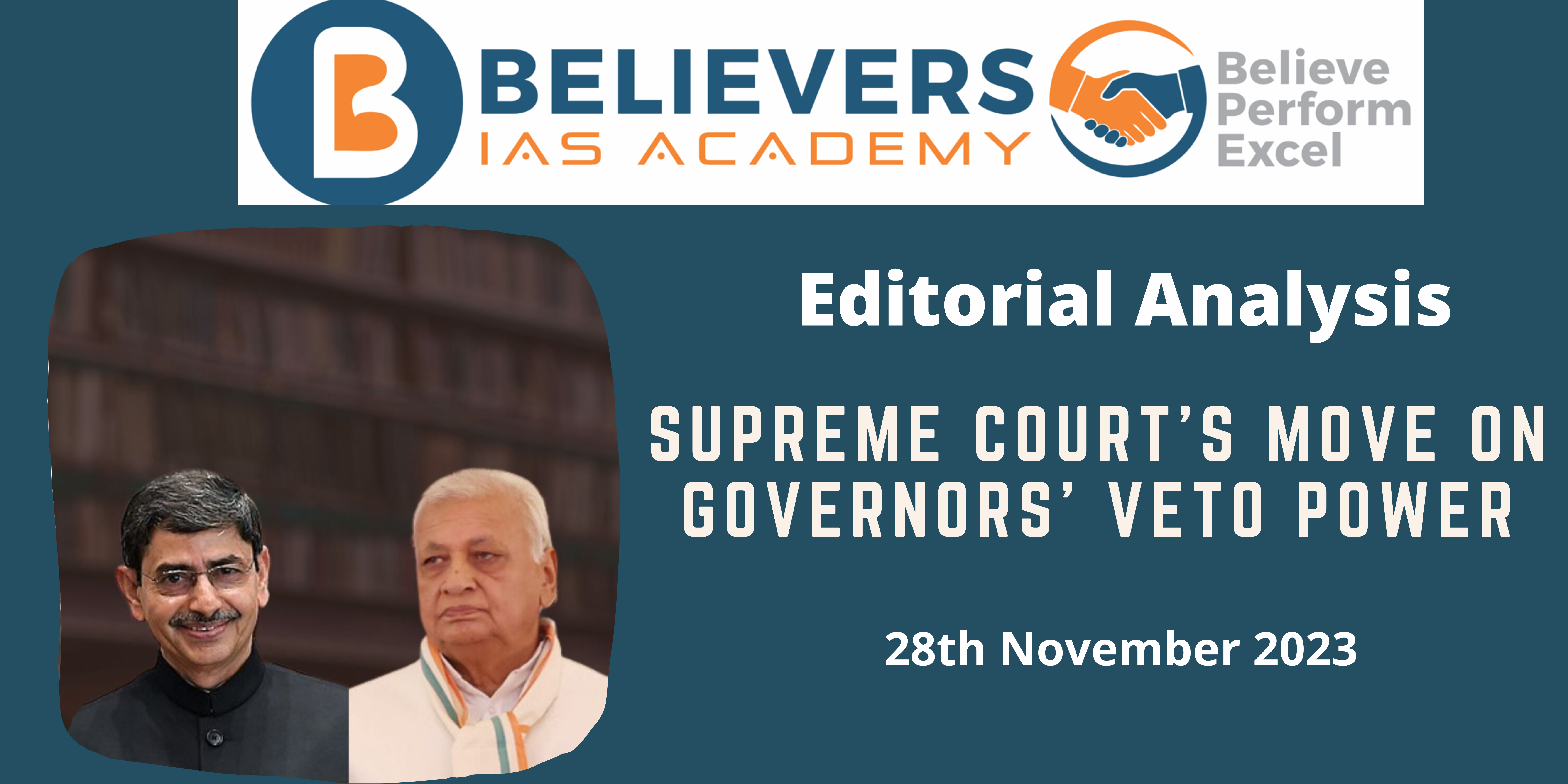Supreme Court’s Move on Governors’ Veto Power
Context:
In parliamentary democracy, the recent intervention by the Supreme Court regarding the authority of Governors in the legislative process marks a noteworthy development.
- The specific case from Punjab, where Governor Banwarilal Purohit chose to withhold assent to certain Bills passed by the State Assembly, asserting their adoption in an alleged illegal session.
- The Supreme Court’s nuanced reading of Article 200, which delineates the grant of assent to Bills, aligns with a fundamental principle of parliamentary democracy – that the elected government, accountable to the legislature, governs the state’s affairs.
- This editorial analysis delves into the dimensions of this judicial pronouncement, unravels its implications, and explores the way forward.
Relevance:
GS-02 (Role of Governor, Judiciary)
Prelims:
Governor’s power over state bills, Article 200, Supreme Court.
Mains Question:
Critically examine the recent Supreme Court ruling that removes the unilateral veto power of Governors over Bills passed by the legislature. Discuss the implications of this decision on the functioning of parliamentary democracy, emphasizing the delicate balance between elected regimes and gubernatorial appointees. (250 words)
Dimensions of the Article:
- Governor’s Authority on State Bills
- The Supreme Court’s Ruling
- Prescribed Time-Frames and Governor’s Obligations
Governor’s Authority on State Bills:
- Article 200: Article 200 of the Indian Constitution delineates the process for a State Legislative Assembly’s passed Bill to reach the Governor for potential assent, withholding, or reservation for the President’s consideration. The Governor can also return the Bill to the Assembly with a message for reconsideration.
- Article 201: It stipulates that when a Bill is reserved for the President’s consideration, the President may either assent or withhold assent. Alternatively, the President can direct the Governor to send the Bill back to the State Legislature for reconsideration.
- Governor’s Options: The Governor’s choices include granting assent, sending the Bill back to the Assembly for reconsideration, or reserving it for the President’s consideration. Reservation is mandatory if the Bill threatens the state high court’s position or if it falls under specific categories such as being against the Constitution, DPSP, national interest, or dealing with property acquisition under Article 31A. Withholding assent, though an option, is seldom exercised due to its potential unpopularity.
The Supreme Court’s Ruling:
- The core of the Supreme Court’s ruling lies in debunking the notion that Governors possess an independent veto power over Bills endorsed by the legislature.
- The interpretation of Article 200, that mandates the Governor to return a Bill to the House for reconsideration, assumes prominence.
- The Court, in aligning the power to withhold assent with the proviso, establishes a sequential process wherein the Governor either assents initially or is compelled to do so after the Bill’s second passage.
- The ruling provides clarity on the legitimacy of grounds cited by Governors for withholding assent. In the specific case of Mr. Purohit’s contention that the Assembly session was illegal, the Court rejects this argument by distinguishing between adjournment and prorogation. This distinction becomes a pivotal aspect of the judgment, guiding future instances where Governors might attempt to utilize procedural irregularities as grounds for withholding assent.
Prescribed Time-Frames and Governor’s Obligations:
- The Court’s emphasis on the “as soon as possible” proviso underscores the obligation of Governors to act promptly.
- This serves as a direct response to the tendency of some Governors to delay actions on Cabinet or legislative proposals, exploiting the absence of a defined time-frame.
- The ruling, in this context, attempts to restore a sense of urgency and accountability in the gubernatorial role.
Way Forward:
- It is important to focus in a harmonious relationship between elected regimes and gubernatorial appointees, where the principles of democratic governance and accountability take precedence over potential conflicts.
- The Supreme Court’s intervention serves as a corrective measure, redefining the contours of Governors’ authority in the legislative process. The judgment aligns with the essence of parliamentary democracy, emphasizing prompt and accountable action.
- As the legal landscape evolves, this decision stands as a beacon, steering the delicate balance between elected governments and gubernatorial appointees toward a more harmonious coexistence.




